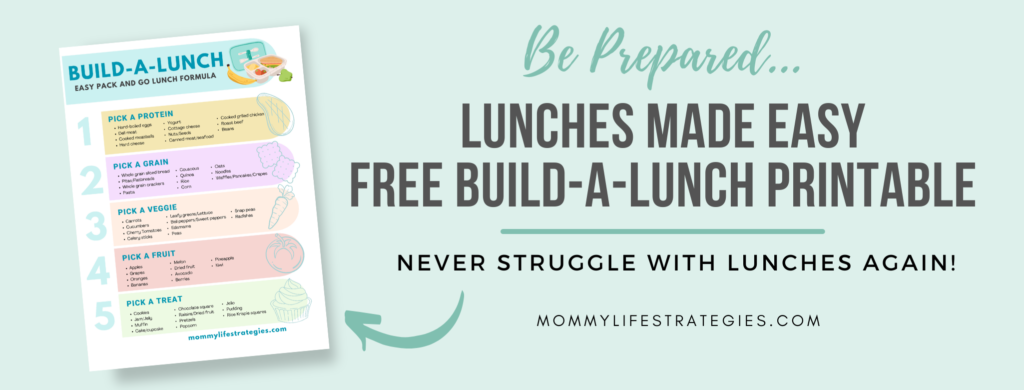
Are you prepared for the back-to-school routine? If not, it’s best to start as early as you can and a lunchbox plan is a good place to start. Lunches seem like a small task that doesn’t need advance prep, but it can be really time-consuming and even frustrating if you’re not prepared.
In this post, I’ll share how best to pack them so they maintain the right temperature and texture. As well as answers to common questions or concerns about the best foods for lunches, and ideas for storing lunches for your kids. Plus, I’ll cover an easy-to-use lunch-building formula that makes packing lunches super easy so your kids will want to pack their lunch every day.
Disclosure:Some of the links below are affiliate links. As an Amazon Associate, I earn from qualifying purchases. That means that, at no extra cost to you, I will earn an affiliate commission. Learn more about it on my disclaimer page.
Make lunches easy for you and your family, grab my free Build-A-Lunch printable. Print and stick on your fridge so you and your kids can make lunches fast and easy!
Need an easy lunch formula?
Be prepared with a plan for lunches before school starts. Don’t waste time trying to think of different ways to make lunch, use my Build-A-Lunch printable. It’s an easy way for you and your family to build their own lunch without your help. So, you can be hands-off for this task and be confident in knowing lunches will be made and made well.
Got picky eaters? No problem. Let them choose from the list of foods so you don’t have to hear complaints about lunches they don’t like because they chose their lunch.
You’re the only one packing lunches? Not anymore. My build-a-lunch guide is easy to follow so that even your kids can pack their lunch without you having to take over.
Packing essentials for Lunches
Containers
Lunches can be stored in any container. Any material whether it be plastic, glass, ceramic or stainless steel will work fine provided it has a good seal and can open easily.
Pros:
- Huge variety of sizes and styles at most department stores.
- Most are dishwasher, and freezer safe.
- Affordable.
- Durable.
Cons:
- Risk staining and absorbing odors from food and soap when cleaning.
- Will degrade over time and crack.
- While dishwasher safe, most are top rack only and can warp the lids.
- Lids can be difficult to manage in a cupboard and add to clutter.
Insulated Bags
Most insulated bags are made of durable materials and keep foods cold or hot. Just like storage containers, they come in a variety of styles and sizes.
Pros:
- Variety of styles and sizes.
- Keeps food hot and cold for many hours.
- Lots of space to include a water bottle and other irregular sized items.
Cons:
- Can be bulky and too big to fit into a backpack.
- Extra baggage – have to carry lunch bag in addition to other bags for school or work.
Bentos & Sainless Steel lunchboxes
Bento-style boxes are very popular since they keep all foods together in one container but inside it has compartments to keep foods separated. Most are easy to wash and are durable.
Pros:
- Pack entire lunch in one container. Allows variety.
- Keep foods separated and prevents sogginess or mixing of flavors.
- Stylish – comes in a variety of colors and designs.
- Kids and grown-ups love them.
- Makes lunchtime exciting.
Cons:
- Depending on the box, you might have to handwash only. Check cleaning instructions on the package.
- Can be pricey if not purchasing on sale.
- Might leak if doesn’t have a proper seal on the container.
Lunchbox Accessories
Food picks, organizers, cutlery sets, crustables maker/shaped sandwiches, veggie cutters/patterns, ice-packs, sandwich/snack bags, hand & face wipes, reusable/washable cloths and food wraps. Lunchbox cards/notes. Reusable yogurt silicone tubes. Apple sauce, drinkable yogurt/kefir silicone packs reusable. Reusable/dishwasher safe drink boxes, water bottles, thermos.
Tips: Keeping Temperature, Flavor and Texture
Foods that freeze well and the ones that don't
Thankfully, there are many foods that you can safely freeze without compromising on taste and texture. Here’s a list of common lunch foods that you can freeze and others that are best not to freeze.

Yes:
Sandwiches: Nut or seed butter, tuna, deli-meat sandwiches (avoid cheese as it might break apart, but cheddar might work well).
Baked goods: Bread, buns, cake, muffins, waffles and crepes (no icing, jelly, or syrup).
Meats: Cooked roast beef and grilled chicken. Meatballs (with or without sauce).
Grains: Pasta. Any cooked grain as long as plain (no sauce, keep separated). Separate pasta from sauce when freezing and combine when thawed
Dairy: Yogurt and smoothies (use silicone yogurt or popsicle molds).
Soups: Stews, chilis, and soups without pasta or noodles (risk a too mushy texture).

No:
Sandwiches with sauces or jams, water-rich foods like tomatoes, lettuce, onions, and pickles.
Pre-baked pizzas and pies (meat or fruit) because of the potential to over bake, making it dry and burnt tasting.
Lunch Ingredients List
Here’s a list of good ingredients to help you make lunches without hassle. Use this list to create your own lunch formula. Choose 1 from each category, pack and go.
Here’s a simple lunch formula you can use:
Pick a Protein – Pick a Grain – Pick a Veggie – Pick a Fruit – Pick a Treat
*Check with your school or learning space in advance to find out what the food restrictions are. Most schools are nut-free but some may also forbid other foods like dairy, egg, hard foods, chocolate, etc.
Protein:
- Hard-boiled eggs
- Deli meat
- Cooked meatballs
- Hard cheese
- Soft/cream cheese
- Yogurt
- Cottage cheese
- Nuts/Seeds
- Canned meat/seafood
- Cooked grilled chicken
- Roast beef
- Beans
Veggies:
- Carrots
- Cucumbers
- Cherry Tomatoes
- Celery sticks
- Leafy greens/Lettuce
- Bell peppers/Sweet peppers
- Edamame
- Peas
- Snap peas
- Radishes
Fruit:
- Apples
- Grapes
- Oranges
- Bananas
- Melon
- Dried fruit
- Avocado
- Berries
- Pineapple
- Kiwi
Gains:
- Whole grain sliced bread
- Pitas/Flatbreads
- Whole grain crackers
- Pasta
- Couscous
- Quinoa
- Rice
- Waffles/Pancakes/Crepes
- Noodles
Treats:
- Cookies
- Jam/Jelly
- Muffin
- Cake/cupcake
- Chocolate square
- Raisins/Dried fruit
- Pretzels
- Popcorn
- Jello
- Pudding
- Rice Krispie squares
Pre-Packaged
- Cheese sticks
- Granola bars
- Cookies
- Crackers
- Pea snaps
- Lentil Chips
- Cereal
- Juice box
- Milk box
- Apple sauce
- Fruit cocktail
- Fruit leather
Sauces and Dips
- Hummus
- Chocolate hummus
- Ranch dip
- Marinara
- Tzatziki
- Salsa
- BBQ
- Onion dip
- Fruit puree/sauce
Make lunches easy for you and your family, grab my free Build-A-Lunch printable. Print and stick on your fridge so you and your kids can make lunches fast and easy!
FAQs: Preparing Lunches
How do I rotate lunches?
When life gets crazy, we can sometime get into the habit of packing the same PBJ sandwiches, carrot sticks and juice box. It’s a yummy lunch but you and the kids might start getting tired of it. Planning ahead can help you add some variety. If sandwiches are convenient, make in different flavors and styles. Example, Monday – Deli meat and cheese, Tuesday – Tuna Salad, Wednesday – PBJ, Thursday – leftovers, Friday – Pasta or Mini Pizza.
Can lunches be frozen?
Luckily most lunches can be frozen. Refer to the list mentioned above of Foods that freeze well and the ones that don’t. A good rule is to avoid freezing foods that are high in water content because you risk it ruining the texture of the food. The same goes for foods in sauces, or jams.
Be careful with foods already cooked because when reheated they can get overcooked, dry and ruin the flavor.
How long can premade lunches last in the fridge?
The general rule is 3-5 days and that depends on the food you prepared and how cold your fridge is. Any food with high water content or a lot of moisture, you don’t want sitting in the fridge for more than 3 days.
How can I prevent lunches from getting soggy or stinky?
If you’re batching food or have leftovers, it’s a good idea to let cooked food cool before putting them in the fridge so they maintain a good texture when it’s time to reheat and eat.
Keep water rich foods separated from dry foods. Think tomatoes and pickles on sandwiches. The juices will be absorbed by the bread making it soggy.
Hold off putting condiments on food and instead put them in a separate container.
Are there any healthy pre-packaged options?
There are many health pre-packaged foods you can add to lunches when you are really short on time. Hard boiled eggs, meat and cheese snack packs, trail mixes, dehydrated or freeze-dried fruit or veggies, protein/energy bars, seaweed snacks, seasoned tuna mini-cans, cheese sticks, fruit and veggie platters, popcorn and lentil chips are a few you can add when you need to shave off a little bit more time.
Tips for simplified and faster lunch prep
- Get family members to make their own. If you have children old enough to make their own lunch, let them. It promotes independence and confidence in your kids. And it’s one less task on your long to-do list. Everyone wins!
- If you don’t have time to prep fruit and vegetables in advance, buy them precut or diced. Buy a fruit and veggie platter for the first week back at school to make building your lunches easier. This also applies to precooked foods like meat and hard-boiled eggs which can be purchased already cooked and cut.
- Separate noodles or pasta from broth if possible. Keep a thermos for hot broth and noodles in another container and combine when ready to eat so they are not mushy.
- Label containers so family members know which lunch is theirs.
- Place prepared lunches in the fridge where you can see them. Mornings can be rushed, and lunches forgotten so make sure that you can see it. Put it in backpacks with ice packs as soon as you can.



















